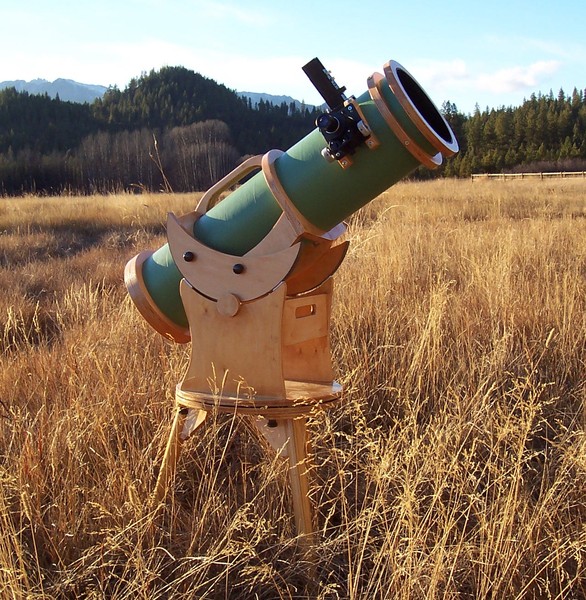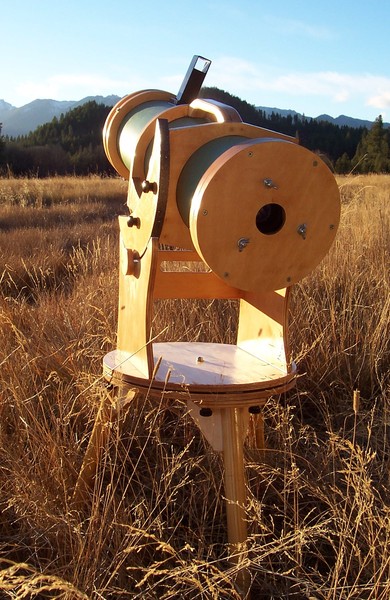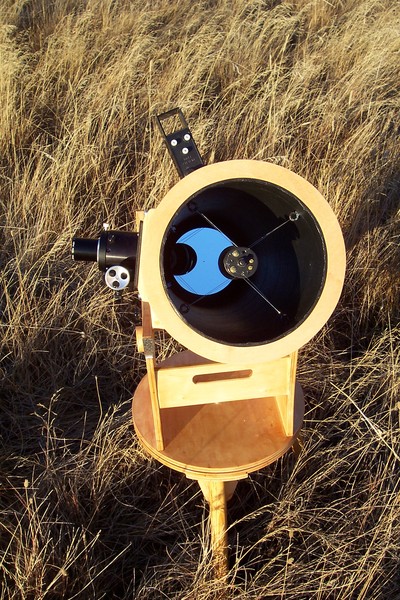
Home Telescopes Mirror Making Contact Site Map
Home --> Telescopes --> 6 inch Dob

I decided to make a 6 inch mirror for practice before I attempted to grind, polish, and figure a 12 inch mirror. But I ended up having a lot more fun building the telescope than I anticipated, though I experienced many dead ends and while making the mirror.
The tube is a concrete form tube (like Sonotube). Nearly all of the wood is Baltic Birch plywood. The bearings are Teflon and Ebony Star countertop laminate. The extra tube ring near the top end of the tube is necessary to support the wire spider.
 |
| The back of the telescope. The three primary mirror adjustment screws (wing nuts) are shown. The round hole is for a fan to cool the mirror, which was not yet installed when I took this picture. |
Many modern homebuilt Newtonian telescopes contain wire spiders. Offset wire spiders are built kind of like a bicycle wheel: thin wires under tension hold the center hub stiffly in place. Offset wire spiders have the advantages of a very narrow profile and high stiffness. I found several web pages describing wire spiders, but I didn't find any information about making a wire spider for such a small telescope. So, I made my own design.
For more details, see my wire spider page.
 |
| The wire spider is visible in this picture. |
Some of the telescope design was based on Kriege and Berry's book The Dobsonian Telescope. Even though it is geared toward large aperture telescopes, there is a detailed chapter at the back of the book about making a small 8" f/6 telescope.
The focuser is a model RCF-1 from JMI. The unit-power finder is a Rigel Systems Quikfinder.
The crescent moon shaped side bearings are removable, allowing the telescope to fit in a wood box which goes on top of my minivan. The side bearings are held in place by two knobs each.
The cradle is not a box like on traditional Dobsonian telescopes. Instead, it consists of two rings with three pieces of wood connecting them, once of which serves as a handle. The rings have flat sides to allow the side bearings to be bolted to a flat surface.
The cradle and tube rings are made from 3/4" Baltic Birch plywood. The rocker and ground board are made from 1/2" Baltic Birch plywood. Surprisingly, Baltic Birch isn't a whole lot more expensive than cheap plywood found at home improvement stores. I bought a 5x5 foot sheet of 1/2" plywood and a 5x5 foot sheet of 3/4" plywood for under $100 (US).
I wanted the telescope to be at a height such that my youngest daughter (age 6) can see through the eyepiece with the telescope pointed at the zenith while standing on a short stool. The height of the eyepiece ranges between 35 inches when viewing the horizon and 45 inches when viewing the zenith; these heights also allow comfortable viewing for me when sitting in a chair. To make the telescope this tall, I made three legs from 1 3/8" diameter closet rod dowels and some 1/2" plywood braces. Each leg attaches solidly to the ground board with three knobs.
The mirror cell closely follows the design in Kriege and Berry's The Dobsonian Telescope. Collimation is straightforward, since the tube is short enough that I can turn the collimation screws with my eye at the eyepiece.
You can also read more about the filter slide and mirror fan, which I added to the telescope after taking the pictures on this page.
I was very pleased with the result when I used the telescope for the first time under a dark sky near Leavenworth, Washington on November 10, 2007. With my lowest power eyepiece (an old Tele Vue 32 mm "Wide Field"), the North America Nebula barely fit in the field of view, making me happy that the telescope is short focus. Comet Holmes was magnificent, nearly filling the field of view at 83x. Coma, an aberration which plagues short focus Newtonian telescopes, is tolerable even at low power.
Although I'm looking forward to working on my 12 inch telescope and seeing many objects I've never seen before, I know that the wide field and portability of this small telescope is something that I will always enjoy.